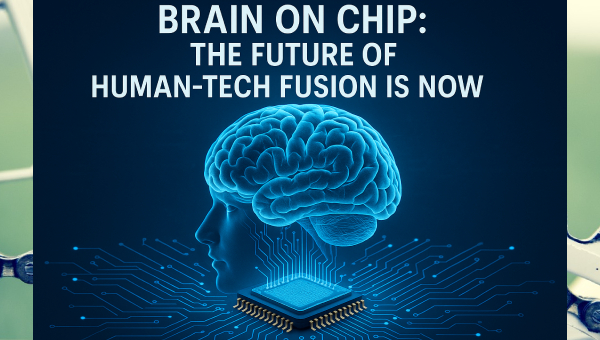Brain on Chip: The Future of Human-Tech Fusion Is Now

As the world of science and technology develops further, the boundary between biology and its machine is increasingly becoming indistinct. One of the most exciting and groundbreaking developments concerns the relatively new concept of the so-called Brain on Chip, which is also a scientific and technological breakthrough that is changing the way the human brain and the concept of interacting with artificial intelligence are perceived. This innovation is not a far-fetched idea in the 21st century but as we move on this century, it is already taking shape. A life in which humans and technology are inseparable may not be a sight of the next generation it is here and now.
The Theory of Brain on Chip
In essence, Brain on Chip is the outcome of an interplay between cerebral science, engineering, and miniature technology. It is concerned with the creation of a micro-scale machine, which will simulate the neurons in the human brain. These chips tend to be constructed with sometimes soft polymers, with embedded live brain cells or neurons, and they will reproduce the basic component of brain functions like synapses, neural circuits, and signal transmissions.
Essentially such chips are designed to reproduce the complexity and the functionality of the brain tissue within a controlled environment. They can be used in a variety of ways: to research neurological illnesses and test pharmaceutical products, create the basis of neuro-computing systems which may be combined with human thought.
The Translation from Laboratory to Life
This idea was first developed in early computational neuroscience and bioinformatics. The origins of digital models of brain activity are in the research by scientists but they have acquired limitations later when the imitation of the functioning of true neural circuits was intended in terms of chaotic, flexible, and highly efficient functioning. That gave rise to brain organoids, simplified, tiny versions of the brain that are cultivated in a lab from stem cells.
As the research developed further, scientists succeeded in incorporating such brain tissues into microchips via microfluidic platforms- miniaturized structures that process liquids on the microscopic scale.
By doing this, it was possible to monitor, electrically stimulate, and manipulate neural activity in real time, and the result was the development of a so-called Brain on a Chip.
Institutions like Harvard, MIT, and Stanford are leading the way today on this kind of research. Innovation by companies such as Cortical Labs and Neuralink also contributes to the private sector, expanding the realm of what can create the brain-machine interface.
Medical Applications
The application of Brain on Chip is one of the most imminent and promising effects in the domain of medicine. Neurological diseases such as Alzheimer's, Parkinsonism, epilepsy, and multiple sclerosis affect millions of people in the world. Incumbent drug development and testing procedures are time-consuming, cost-prohibitive, and not always applicable to forecasting human reaction.
Brain-on-Chip models are recreations of human neural tissue and enable researchers to test treatments in an efficient and ethically acceptable manner. They are in a position to reproduce the progression of diseased states and witness the cellular reaction and predict the way a patient will react to a specific drug in a specific outcome- all this without experimenting with human beings.
Furthermore, a patient-specific brain can be created by using this technology with personal stem cells. It brings a new age of individualized medicine where not only is it faster and safer to develop, but it is also specific to a person, genetic make-up.
Artificial Intelligence by Revolution
Although the recent AI applications, such as ChatGPT, Siri, and autonomous vehicle automatons, are running on a rule-based logic and deep learning techniques, they do not possess any real consciousness, flexibility, or introspection. The candy innovation is the Brain on Chip.
With all the advantages, AI can be further redefined as it will be more intuitive, energy-efficient, and even capable of self learning, even without massive datasets by simply imitating the real-time processing/decision-making capability of biological neurons. Neural networks can exploit a quality that can not be realized using silicon-based chips, namely the ability to evolve, reconfigure, and even self-heal in response to problems.
Consider AI programs that do not simply analyze data but are capable of analyzing data in the same way that a human brain would do, with a sense of context and background. Artificial general intelligence (AGI) Brain-inspired computing platforms may one day give rise to artificial general intelligence, a form of AI that can learn any intellectual task and potentially do it better than a human.
Conjoining Human and Computers
The most intriguing and provocative (probably) thing about the brain-on-chip is that it can potentially be used to augment a human being. The brain implants that might restore vision, all the way up to being able to communicate among paralyzed people, are already being tested by such companies as Neuralink.
However, Brain on Chip goes even further and plants the needle. With real biological brain tissue being employed in the computing system, researchers are experimenting with two-way traffic ways connection between the human brain and the external hardware. The technology is redefining humanity. As we put living neurons into digital systems, we are entering the world of neuro-enhancement:
where the cognitive abilities of humans can be extended well beyond the natural limitations. This would imply:
- Uploading wares or talents
- Digital interface through the mind
- Distance brain-to-brain communication
- The brain-enhanced learning or problem-solving in real-time
Ethical Issues and Social Effects
Like any potent innovation, Brain on Chip evokes a great number of ethical questions. Who owns a chip made from a piece of a human brain? Are these devices a source of consciousness? Is our human identity and individuality going to be jeopardized by merging human brains with machines?
The possibility of abuse is also imminent. Imagine a world in which neurotechnology is used by corporations or the government to eavesdrop, control our thoughts, or even modify our behavior. The gap between the people who can and those who cannot access neural augmentation may worsen the preexisting social disparities, establishing a level of cognitive elites.
Data security is yet another urgent issue. Just because a chip in the brain can transmit data and receive it does not mean that it cannot be hacked. The neural data security and privacy will be as significant as the security of the brain. Global and ethical systems of governance, rules, and mechanisms need to change in line with the technology to think responsibly when traversing this landscape.
The Transformation of Workforce and Education
As Brain on Chip rises, our systems of education and employment have to embrace the change. With machines getting more brain-like and being competent in what humans can do, we people need to concentrate on what humans are naturally good at: creativity, emotional intelligence, ethical reasoning, and empathy.
There might emerge new professions: neurotechnicians, AI psychologists, memory engineers, and digital ethics auditors. In the meantime, established job positions might change or become eliminated with the AI-human amalgamations joining the market.
Educational systems will require not only to train in coding or science, but also to think about the role of technologies in human evolution. The brain, neuroscience, and ethical consciousness of AI should become a new component of digital literacy.
The Future: A Hybrid Future
Brain on Chip portrays the future, not the kind where people have subjugated the biological world to the digital one but one where the two co-exist in harmony. Rather than substituting people, brain-like machines could make our thinking buddies for us by enabling us to conquer illness, acquire new scientific insight, and grow our mental capacity. As a result of such a combination between organic and artificial, there is the possibility of entering into an era, not only of technological development, but of human development as well. In the world, things would be different in the following manner:
- Students become faster learners by using neural chips.
- Doctors work based on real-time thinking input.
- Artists have partnered with machines to work at the edge of creativity.
- Human beings are in existence with digital co-pilots who are interlinked directly to their thoughts.
Conclusion
Brain on Chip is not about a scientific achievement but a new philosophical threshold. It makes us reconsider what consciousness, intelligence, and identity are. The road to travel is full of difficulties, ethical as well as technical, but the benefits that can come through are immense. It is not yet the robots that imitate life anymore. We are creating the future that is co-engineering life and machine. Whether we will fall into this human-tech fusion, the question is how lovingly and intelligently we are going to do this. The future is not coming around the corner it is already beating on the microchips of the present laboratories. Brain on chip is here and it brings the advent of hybrid humankind.
Must read this: Neurotech: Hacking the Brain for Health and Enhancement








